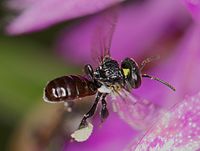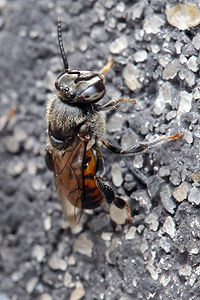
Perception, regulation, and fitness effects of pollen phytosterols in the bumble bee, Bombus terrestris.
Sign Up to like & getrecommendations! Published in 2023 at "American journal of botany"
DOI: 10.1002/ajb2.16165
Abstract: PREMISE Many flowering plants depend on insects for pollination and thus attract pollinators by offering rewards, mostly nectar and pollen. Bee pollinators rely on pollen as their main nutrient source. Pollen provides all essential micro-… read more here.
Keywords: pollen; sterol; bee; fitness ... See more keywords

Individual bee foragers are less efficient transporters of pollen for the plants from which they collect the most pollen into their scopae.
Sign Up to like & getrecommendations! Published in 2023 at "American journal of botany"
DOI: 10.1002/ajb2.16178
Abstract: PREMISE Bees provision most of the pollen they remove from anthers to their larvae and transport only a small proportion to stigmas, which can negatively affect plant fitness. Though most bee species collect pollen from… read more here.
Keywords: plant species; pollen; less efficient; plant ... See more keywords

The effect of habitat fragmentation on the bee visitor assemblages of three Australian tropical rainforest tree species
Sign Up to like & getrecommendations! Published in 2018 at "Ecology and Evolution"
DOI: 10.1002/ece3.4339
Abstract: Abstract Tropical forest loss and fragmentation can change bee community dynamics and potentially interrupt plant–pollinator relationships. While bee community responses to forest fragmentation have been investigated in a number of tropical regions, no studies have… read more here.
Keywords: tree species; bees visiting; australian tropical; bee ... See more keywords

Drivers of diversity and community structure of bees in an agroecological region of Zimbabwe
Sign Up to like & getrecommendations! Published in 2021 at "Ecology and Evolution"
DOI: 10.1002/ece3.7492
Abstract: Abstract Worldwide bees provide an important ecosystem service of plant pollination. Climate change and land‐use changes are among drivers threatening bee survival with mounting evidence of species decline and extinction. In developing countries, rural areas… read more here.
Keywords: bee abundance; diversity; community; zimbabwe ... See more keywords

Bee Tracker—an open‐source machine learning‐based video analysis software for the assessment of nesting and foraging performance of cavity‐nesting solitary bees
Sign Up to like & getrecommendations! Published in 2022 at "Ecology and Evolution"
DOI: 10.1002/ece3.8575
Abstract: Abstract The foraging and nesting performance of bees can provide important information on bee health and is of interest for risk and impact assessment of environmental stressors. While radiofrequency identification (RFID) technology is an efficient… read more here.
Keywords: software; solitary bees; cavity nesting; nesting solitary ... See more keywords

Agricultural buffer zone thresholds to safeguard functional bee diversity: Insights from a community modeling approach
Sign Up to like & getrecommendations! Published in 2022 at "Ecology and Evolution"
DOI: 10.1002/ece3.8748
Abstract: Abstract Wild bee species are important pollinators in agricultural landscapes. However, population decline was reported over the last decades and is still ongoing. While agricultural intensification is a major driver of the rapid loss of… read more here.
Keywords: agricultural buffer; bee; bee diversity; community ... See more keywords

Abundant, distinct, and seasonally dynamic bee community in the canopy‐aerosphere interface above a temperate forest
Sign Up to like & getrecommendations! Published in 2023 at "Ecology and Evolution"
DOI: 10.1002/ece3.9739
Abstract: Abstract Our understanding of how bees (Apoidea) use temperate forests is largely limited to sampling the understory and forest floor. Studies over the last decade have demonstrated that bee communities are vertically stratified within forests,… read more here.
Keywords: ecology; canopy aerosphere; temperate forest; aerosphere interface ... See more keywords

Negative impacts of dominance on bee communities: Does the influence of invasive honey bees differ from native bees?
Sign Up to like & getrecommendations! Published in 2021 at "Ecology"
DOI: 10.1002/ecy.3526
Abstract: Invasive species can reach high abundances and dominate native environments. One of the most impressive examples of ecological invasions is the spread of the African sub-species of the honey bee throughout the Americas, starting from… read more here.
Keywords: invasive honey; bee; native bees; dominance ... See more keywords

Petals and leaves: quantifying the use of nest building materials by the world's most valuable solitary bee.
Sign Up to like & getrecommendations! Published in 2021 at "Ecology"
DOI: 10.1002/ecy.3584
Abstract: The alfalfa leafcutter bee (Megachile rotundata, hereafter simply "leafcutter bee") is a solitary, cavity-nesting bee native to Eurasia, managed as an agricultural pollinator of alfalfa and several other crops in North America since the 1940s… read more here.
Keywords: cane 2011; pitts singer; valuable solitary; singer cane ... See more keywords

Assessment of the vulnerability to pesticide exposures across bee species.
Sign Up to like & getrecommendations! Published in 2021 at "Environmental toxicology and chemistry"
DOI: 10.1002/etc.5150
Abstract: In many countries, the Western honey bee is used as surrogate in pesticide risk assessments for bees. However, uncertainty remains in the estimation of pesticide risk to non-Apis bees because their potential routes of exposure… read more here.
Keywords: vulnerability pesticide; honey; pesticide; bee species ... See more keywords

Comparison of the Sensitivity of Tetragonisca angustula (Apidae‐Meliponini) and Apis mellifera (Apidae‐Apini) to Three Insecticides (Malathion, Imidacloprid, and Fipronil) Used in Costa Rica
Sign Up to like & getrecommendations! Published in 2023 at "Environmental Toxicology and Chemistry"
DOI: 10.1002/etc.5587
Abstract: The decline of insect pollinators is a significant concern within the current biodiversity crisis. The paradox between the benefits that these animals represent to humans and the evidence of human activities driving their extinction calls… read more here.
Keywords: three insecticides; fipronil; apidae; bee ... See more keywords